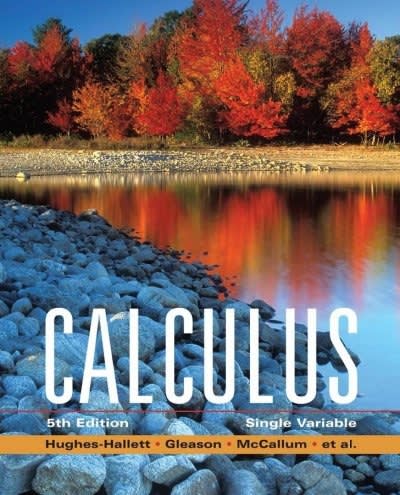Question
One application of integration is the computation of the length of curves in the plane, aka arc length. In this worksheet, you will develop a
One application of integration is the computation of the length of curves in the plane, aka arc length. In this worksheet, you will develop a formula for arc length by analyzing the special case of the parabola y = x 2 in detail.
Problem 1. Let f(x) = x 2 . We would like to find the length of the parabola y = f(x) from (0, 0) to (1, 1). As a first step, we will approximate this length using the line segment from (0, 0) to (1, 1) (see the figure below). What is the length A1 of this line segment? (If you are not sure how to find this length, try to realize it as the length of the hypotenuse of a right triangle, and then use the Pythagorean theorem.) Show all of your work
Problem 2. Now approximate the arc length using four lines segments, each with the same x. Is y the same for each x? Explain. approximate as a Riemann sum with N = 4
Problem 3. Clearly we have improved our approximation of the arc length by increasing the number of line segments. Now imagine breaking the curve into a lot of small pieces. In the j-th piece the curve goes across a distance xj and up a distance yj , and so has approximate length p (xj ) 2 + (yj ) 2 . Draw a picture that clearly explains the previous sentence.
Problem 4. Recall from the microscope equation that y dy dxx. Use this result to rewrite p (x) 2 + (y) 2 in terms of dy dx and x. Simplify the expression and write in the form x YOU FILL IN
Problem 5. For y = x 2 , what does the simplified expression found in part (5.) become?
Problem 6. Write down an explicit Riemann sum that gives an approximation for the curve y = x 2 form (0, 0) to (1, 1) using N = 100 pieces and evaluating the derivative at the right-hand endpoints of each subinterval.
Problem 7. As N , the Riemann sums in part (7.) approach a specific definite integral (e.g., something like R 4 1 2 + x dx). Write down this definite integral, but do not try and compute it.
Problem 8. Generalize the result in part (8.). If y = f(x) is a differential function, then the arc length from (a, f(a)) to (b, f(b)) is given by the definite integral
Step by Step Solution
There are 3 Steps involved in it
Step: 1

Get Instant Access to Expert-Tailored Solutions
See step-by-step solutions with expert insights and AI powered tools for academic success
Step: 2

Step: 3

Ace Your Homework with AI
Get the answers you need in no time with our AI-driven, step-by-step assistance
Get Started


